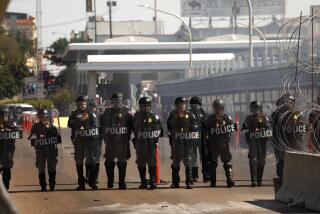A terrorist on every corner?
- Share via
PRESIDENT BUSH and Atty. Gen. Alberto Gonzales insist that the National Security Agency’s warrantless wiretapping of American citizens is a necessary “terrorist surveillance program.” And polls show that most Americans support permitting the government to tap the phone calls and e-mails of those considered “suspicious.”
But what exactly does that mean? A close look suggests that the feds’ definition of a “suspected terrorist” may not meet the laugh test.
In the mass roundup of more than 1,200 people shortly after 9/11, for example, it took very little for a Muslim or Arab illegal immigrant to be considered a “suspected terrorist,” according to a 2003 report by the Justice Department’s inspector general. Arab students were locked up as suspected terrorists for working at pizza parlors (in violation of their student visas); a Pakistani immigrant was jailed after attracting attention because he and his Queens housemates let their grass grow long and hung their underwear out to dry on the fence; and one Muslim was arrested because “he had taken a roll of film to be developed and the film had multiple pictures of the World Trade Center on it but no other Manhattan sites,” the inspector general noted. Some FBI agents were even instructed to look in phone books to find Arab- or Muslim-sounding names, according to Newsweek columnist Steven Brill.
The Department of Homeland Security in May 2003 urged 18,000 local and state police departments to treat critics of the war on terror as potential terrorists, according to a confidential DHS memo made public in 2004. Suicide bombers, the feds told local lawmen, could be detected by such traits as a “pale face from recent shaving of beard”; they “may appear to be in a ‘trance’ ”; their eyes may “appear to be focused and vigilant”; and their clothing may either be “out of sync with the weather” or just “loose.”
The Transportation Security Administration is also extremely arbitrary in how it designates names for its “no-fly” list. There are an estimated 70,000 names in the registry -- many of them stuck there for reasons that even the government cannot explain. Sen. Edward M. Kennedy (D-Mass.) and Rep. John Lewis (D-Ga.) were placed on the list. Everyone with the common name of “David Nelson” is treated like a would-be bomber -- as are 4-year-old children unlucky enough to have a name matching one on the list.
Since December, according to media reports, TSA agents have been chatting up airline passengers to determine if they are terrorists, looking for such warning signs as “involuntary physical and psychological reactions” -- including whether people appear stressed out, frightened or deceptive. The number of people who fear flying outnumber Al Qaeda associates by at least a few thousand-fold, yet visible anxiety will be enough for the TSA to justify taking people aside for far more intensive examination.
And the Pentagon has its own catchall definitions of suspicious and/or terrorist-related behavior. Its “counterintelligence field activity” program, ostensibly set up to protect domestic military bases and personnel, has been covertly gathering information on Americans who have done nothing more suspicious than protest against the Iraq war, including at last year’s antiwar rally at Hollywood and Vine. Names gathered in such fishnets are being added to a Pentagon database involving the “terrorism threat warning process,” according to Newsweek.
When Americans hear Bush say “terrorism surveillance program,” they should recognize that the crosshairs may very well be on them. The more expansive and arbitrary the definition of “suspected terrorist,” the more of our rights the feds can violate. Invoking the word “terrorism” must not raze all limits on the government’s power to target citizens who pose no threat to public safety.
More to Read
Get the L.A. Times Politics newsletter
Deeply reported insights into legislation, politics and policy from Sacramento, Washington and beyond. In your inbox three times per week.
You may occasionally receive promotional content from the Los Angeles Times.










